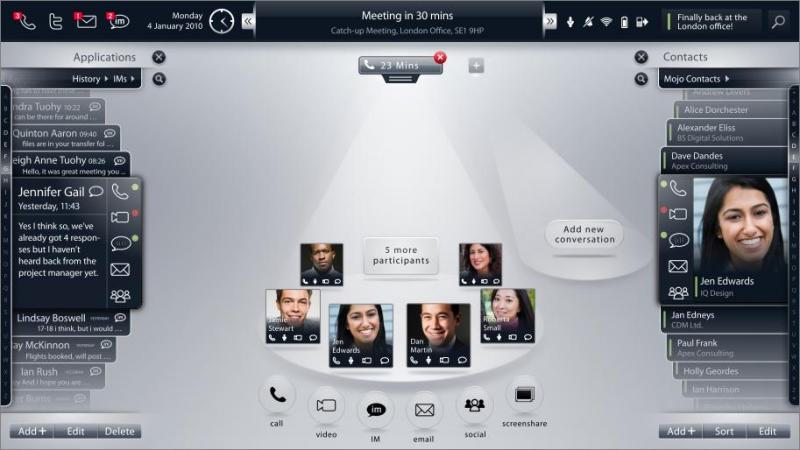Avaya Launches Desktop Video Device, Enters The Collaboration Market
Lots of sleek new touchscreen and tablet devices have launched this year. Where many information workers and consumers see nifty new devices with high-resolution screens and multiple wireless interfaces that enable Web surfing and greater ease of use, I see a new class of device. I call them collaboration devices because I believe that they are especially suited to collaboration tasks that today’s information worker must perform with increasing regularity while on the move. There is an open space in the market for these devices caused by the colliding market forces of an increasing need for employees within a company to quickly and efficiently communicate and the increasing likelihood that these employees will not be in the same location. Most companies today (approximately 60% according to Forrester’s Enterprise And SMB Software Survey, North America And Europe, Q4 2009) are adopting Web conferencing, and information workers are increasingly mobile and distributed — a device that can be on the go and connect to communications and collaboration tools easily will be highly valued. These devices feature slick, usable interfaces and unique connectivity capabilities. Many of these devices run on Android, creating an opportunity and a challenge for Android to enter the business applications market. Android-based devices will fall short of any collaboration aspiration until the marketplace offers standard enterprise Web conferencing tools — where are my Cisco WebEx, AT&T Connect, etc., clients for Android?
I see three categories of these devices :
- Pocket Collaboration. Devices like the BlackBerry Storm or Apple iPhone are first and foremost mobile voice and data devices. These are small, portable devices best suited to tasks like email and calendaring. While these devices have some conferencing (both Web and video) capability, they have smaller screens (3.2” and 3.5”), preventing them from displaying or being used to create more complex data and information; even routine PowerPoint presentations require significant efforts to navigate. Devices like the HTC EVO fall into this category, and the combination with Sprint’s 4G network makes videoconferencing more lifelike. The new Dell Streak (which I have been using for two weeks now) increases the viewing area significantly with a 5” screen, making video viewing and Web conferencing experiences much more rewarding.

Dell Streak
- Corridor Collabboration. Devices like the Cisco Cius and Avaya Desktop Video device (launched today) were designed to connect to and simplify communications via enterprise unified communications and collaboration (UC&C) platforms. These devices will enable a new breed of collaborative information worker — the corridor warrior who works as often in a conference room as an office and is constantly connected via Web and videoconferencing software to peers and colleagues to gather and sift information to drive faster and better decision-making. The larger screens on these devices (7” and 11”) enable significant amounts of data and information to be shared in rich media formats.

Avaya Desktop Video device
- Customer Collaboration. The Apple iPad is the darling of this segment and gets rave reviews from information workers for its sleek user interface, easy operation and general cool factor. One sales leader I spoke with said that he equipped his sales team with iPads partially so that they could quickly start up their sales force automation application, but more importantly so they projected a “cool, high-tech” image. The iPad has a 9.7” screen making it similar to a small netbook in viewing experience.
Avaya also introduced the Avaya Flare experience today at its launch event in New York City, an experience that is designed to simplify an information worker’s daily routine. Avaya’s goal is to extend this experience to any endpoint — phones, PCs, and collaboration devices — that connects to an Avaya Aura architected communications network. The Avaya Flare experience has a very high-tech feel and yet leverages familiar devices like spotlights and a Rolodex-like contacts list to keep the experience real.

Avaya Flare Experience user interface
PGi is in beta trials on a new information worker tool called iMeet, that also focuses on the experience of information workers when collaborating and feels easy to use, almost like a Wii gaming system, connecting to workers via their ecosystem of owned and partner network assets. Cisco recently launched Cisco Quad based on the UI design work of Cordell Ratzlaff, a former Apple executive, who brought deep understanding of the user to the task of designing Web-based tools to create a business-focused social network.
At the end of the day, vendors of these devices will need to design them so that they will fill the now open space in the market — helping information workers connect with each other, share information, create new ideas, and make decisions seamlessly and naturally regardless of location. User experience and seamless multi-network connectivity are the keys to success and I can see progress toward that goal being made differently by each vendor.
CPU: Intel(R) Core(TM)2 Duo CPU P8700 @ 2.53GHz;mhz: 2527;Cores: 2;MB RAM: 2047
Video: Mobile Intel(R) 4 Series Express Chipset Family (4980)